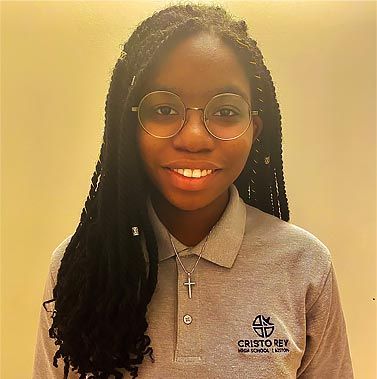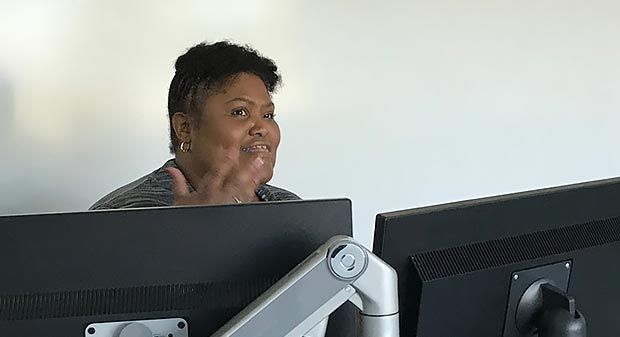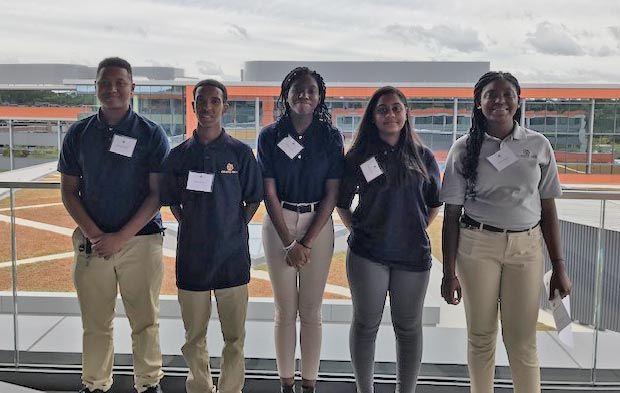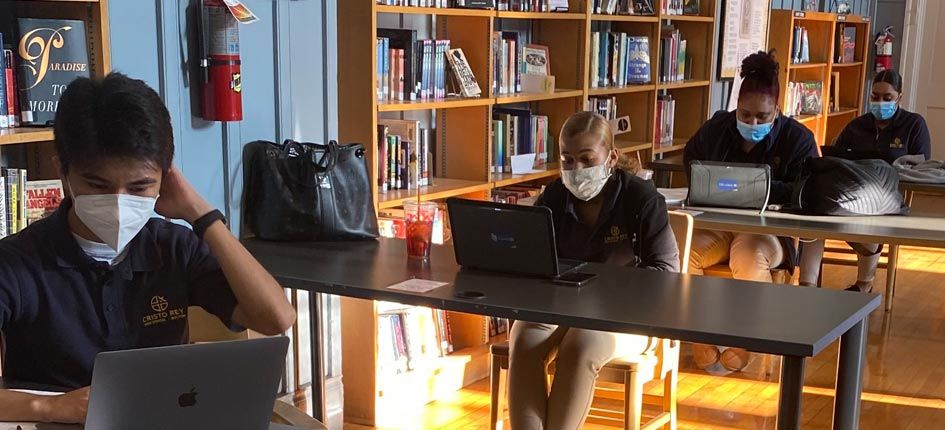Building a Future in STEM
High School Student Discovers There Is More to Coding than a Computer Screen
In 1996, John P. Foley, S.J. had a bold idea to transform secondary education for teens in an economically challenged neighborhood of South Chicago and provide students with the opportunity for a college preparatory–level education. Father Foley introduced a new kind of private high school that combined rigorous academic curricula, religious studies, and a work-study program. For the work-study program, the school partnered with local businesses to place each student in a corporate job throughout the academic year. Not only did the students acquire professional skills and work experience, but the money earned was used to offset the costs of private schooling. The Corporate Work Study Program (CWSP) helped make private high school education affordable.
The school partnered with local businesses to place students in corporate jobs throughout the academic year, giving them professional skills and work experience.
The first Cristo Rey Jesuit High School opened in Chicago in 1996 with only 100 students. Four years later, the program received a $12 million investment to begin replicating its successful model across the U.S. in historically low-income neighborhoods. The Bill and Melinda Gates Foundation would invest another $9.9 million three years later.
Since then, the Cristo Rey Network has grown to 37 schools across the U.S., including Cristo Rey Boston, founded in 2004. For the past 10 years, 100% of graduates from Cristo Rey Boston have been accepted to four-year colleges and universities. The Corporate Work Study Program now has more than 3,000 corporate partners nationally.

Cristo Rey Boston High School. Image credit: Cristo Rey Boston High School
Working Toward a Future in STEM
Based a little less than an hour away from Cristo Rey Boston, MathWorks is in its sixth year participating in the CWSP. When students from Cristo Rey Boston come to MathWorks, they work in departments ranging from finance to facilities, learning about the corporate world while developing career skills and making professional connections.
Over the summer of 2019, Chanelle, then a rising junior at Cristo Rey Boston, developed a fascination with computer coding during an eight-week long program called Girls Who Code. During this summer program, she was introduced to basic coding languages and problem-solving. She loved the challenge.
Work-study program participants from Cristo Rey Boston work in MathWorks departments ranging from finance to facilities, learning about the corporate world while developing career skills and making professional connections.
In the fall of 2019, Chanelle was among a group of students who were selected to work at MathWorks for the CWSP. Each year, MathWorks starts the program with an orientation. The students learn that MathWorks develops software used by engineers and scientists to design products ranging from robots to airplanes and spacecraft. They also discover that it takes many different types of professionals to run a company. They are introduced to people from sales, finance, software development, and operations, to name a few.
After a summer building adventure games in Python and designing HTML and CSS web sites, Chanelle was eager to learn how these same elements were used at MathWorks to wrangle data and solve complex problems. She would become the first high school student to work in a STEM role during her work-study placement at MathWorks.
During the orientation, the students are encouraged to share their interests so that they can be partnered with mentors in the various departments.
“I expressed my interest in engineering because of my coding experience in the summer,” explained Chanelle. “I was hoping to get to work on the technical side of the business.”

Chanelle, student at Cristo Rey High School. Image credit: Chanelle
Luckily, Chanelle’s interests aligned well with the expertise of MathWorks application engineer, Louvere Walker-Hannon. During her more than 20 years in customer-facing engineering roles at the company, Walker-Hannon has been a confident problem solver and leader and a strong advocate for STEM education and for the inclusion of young, underrepresented groups in technology roles. So, when it came time to find a mentor for Chanelle in the company’s engineering side, Walker-Hannon readily volunteered.
“I attended a meeting where the topic was what the students could work on while they were at MathWorks,” says Walker-Hannon. “One of the major themes was trying to do more projects related to programming. That’s how I was able to start working with Chanelle.”
What Walker-Hannon says she initially thought might be one or two info sessions soon bloomed into a full-blown mentorship between them.
Learning the Ropes
Chanelle began to shadow and work with Walker-Hannon on the more technical side of MathWorks. In addition to triumphing in her coding projects, she also learned MATLAB® and how to solve different types of problems. For example, she learned how to manipulate pixels in an image and edit them to change color depth and grayscale.
Chanelle, who is naturally gregarious, says she was immediately excited to learn that being an application engineer meant much more than just sitting at a desk writing code. She learned that an application engineer works directly with customers, guiding them to the best ways to use MATLAB for their projects. Chanelle says she was excited to see how the same coding skills she’d used to build games were also used by companies to develop software for applications such as self-driving cars and medical devices.
“I thought software development would be sitting in front of a computer, writing code all day. But [my mentor] Louvere showed me how I could have the best of both worlds: working on my own code and using my experience to teach others how to code … that’s something I would want to do.”
Chanelle discovered that the application engineers worked closely with other corporate departments, such as the sales and software development teams.
“I definitely had a narrow-minded view at first of what people in technology jobs did: I thought software development would be sitting in front of a computer, writing code all day,” says Chanelle. “But Louvere showed me how I could have the best of both worlds: working on my own code and using my experience to teach others how to code. I saw how she helps customers use MATLAB, how she sometimes writes the code, and how she presents that code to the customers—that’s something I would want to do.”

Louvere Walker-Hannon, Senior MathWorks Applications Engineer. Image credit: MathWorks
While the skill sets used in developing code and communicating it to others may seem unrelated at first glance, Walker-Hannon says that cultivating an approach to problem-solving is really at the heart of the job. Watching Chanelle find satisfaction in improving her problem-solving abilities was a highlight of their time together, says Walker-Hannon.
When Working Turned into Remote Working
Chanelle’s work-study experience was interrupted in March 2020 as MathWorks and Cristo Rey Boston both went remote due to COVID-19, but she says that this change allowed her to connect more deeply with Walker-Hannon’s colleagues across MathWorks.
“I got to meet more of Louvere’s colleagues one-on-one and work with them for a couple of weeks, instead of only meeting them one time,” says Chanelle. “It was cool to learn what they do and get to know them at a deeper level than I did before we went remote.”
Walker-Hannon says that going remote also enabled her and others from MathWorks to present different types of information to the students, including more coding practice and college prep advice. Chanelle met with members of the software development team, the sales team, and other engineers on the application engineering team.
Presentation experience is another professional skill that students in the work-study program at MathWorks develop. To conclude her work experience, Chanelle gave a presentation to MathWorks employees detailing her time and what she had learned.
Walker-Hannon says that her presentation was well received. The team at MathWorks was quite interested to hear about the first engineering work-study experience.

Cristo Rey work-study students from left to right: Brandon, Loukman, Chanelle, Dannya, and Keiana. Image credit: MathWorks
“I got to meet more of Louvere’s colleagues one-on-one and work with them for a couple of weeks, instead of only meeting them one time. It was cool to learn what they do and get to know them at a deeper level than I did before we went remote.”
A Future in STEM
Deftly navigating everything from participating in client meetings to cracking code challenges and working remotely during the pandemic, Chanelle says her experience with MathWorks has transformed her idea of what a STEM career offers. Reflecting on her MathWorks experience, Chanelle says she has a few key pieces of wisdom to pass down to those following in her footsteps.
“Try and be open-minded and always be prepared to learn something new,” says Chanelle. “And make connections with all the people that you meet because you never know if you could intern with them during college or after.”

Cristo Rey students studying on campus during the COVID-19 epidemic. Image credit: Cristo Rey High School
Chanelle says she hopes that her experience working on the technical side of MathWorks will open the door for future students to have similar opportunities.
Leading by example is also something that Walker-Hannon says she hopes she could provide Chanelle during her time at MathWorks as a role model of Black success in STEM.
“I think that representation matters,” says Walker-Hannon. “In other experiences that Chanelle might have in other corporate environments, or school or elsewhere, she may not have the opportunity to interact with as many women—let alone women of color in the tech industry. I’m hoping she saw that she could have a role at MathWorks or another tech company one day.”
As for what is next on Chanelle’s agenda, she is just beginning her senior year and still finalizing her college plans. But one thing is certain: she will return to MathWorks for her final year in the CWSP and will make the most of every experience. She says she is also looking forward to what she will study at college.
“This experience has helped narrow down what I want to do and study in college,” says Chanelle. “I’ve been thinking about studying business, applied mathematics, and engineering.”
“I think that representation matters. In other experiences that Chanelle might have in other corporate environments, or school or elsewhere, she may not have the opportunity to interact with as many women—let alone women of color in the tech industry. I’m hoping she saw that she could have a role at MathWorks or another tech company one day.”
Read Other Stories
Academia
Professor Reengineers MATLAB Course Overnight in Response to COVID
Online and Interactive Tools Simplified the Move to Remote Learning
Green Technology / Control Systems
Containing the Power of the Sun
The Path to Carbon Independence Through Nuclear Fusion
AI
Reconnecting the Brain After Paralysis Using Machine Learning
Brain-Computer Interface Restores Sense of Touch with Haptic Signals